A puzzling hollow kantele SM1910 in the Sibelius Museum, Turku
Blog
February 24, 2024
During the last decade, I photographed and measured all the kanteles in the Sibelius Museum at that time: 8 five-stringed, 7 small kanteles larger than five-stringed, and 27 large kanteles. In addition, there were 8 instruments whose classification is more or less controversial.
In 2019, I published information about the Sibelius Museum’s five-string kanteles, and now I am doing the same for small kanteles with more than five strings.

The kantele SM1910 in the Sibelius Museum in Turku. Photo: Arja Kastinen.
The SM1910 kantele in the Sibelius Museum raises many questions and has few answers. According to the museum, the hollowed-out 11-stringed instrument is a copy made by Carlo Bergman.
The Sibelius Museum has a large number of instruments from Carlo Bergman’s collection, some of which are kanteles. Carlo Bergman graduated from the Cremona Academy of Violinmaking in 1963. His father, Jukka Bergman, was also a violin maker. In addition to violins, Carlo Bergman made e.g. baroque instruments, lutes and kanteles. In addition to making instruments, he had a special interest in the scientific conservation of musical instruments and worked as a conservator at the National Museum of Finland, among other places.

Kantele SM473. Kuva: Arja Kastinen.
Among the small kanteles which are larger than the five-stringed ones, there is also another mentioned as a copy made by Bergman: SM473. It is a copy of the Finnish National Museum’s kantele KM8340. The original instrument is most obviously from Border Karelia and has the exlibris of Tilda and Oskar Hainari on the bottom (– Tilda and Oskar Hainari worked actively for Border Karelia in the late 19th century). The copy made by Bergman was purchased for the Sibelius Museum in 1972.
However, SM1910 was donated to the museum by Bergman’s estate in 2011, and several facts support the idea that it is not a copy, but an original.
The instrument is cracked and has been repaired and mended in several places. For example, a piece has broken off from the tip of the ponsi and the ponsi has several cracks along the top, bottom and sides:
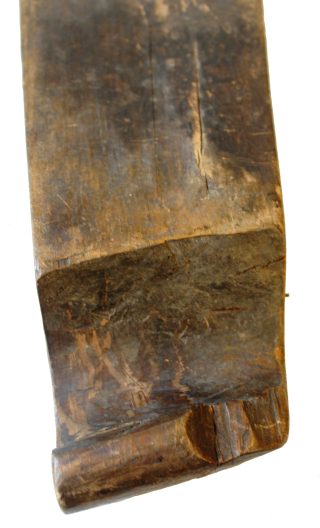
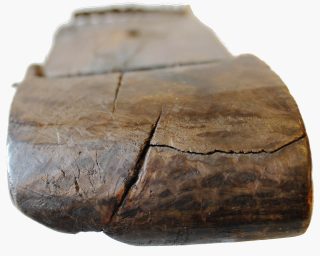
(Although it looks like it, there is no seam on the end side of the bottom, but an incision – the body is hollowed out from the top.)
There are cracks in the sides of the soundboard and many of the small wooden nails used to hold the soundboard in place have come loose. The iron bridge on the tuning pin side has come off on the short side of the instrument.
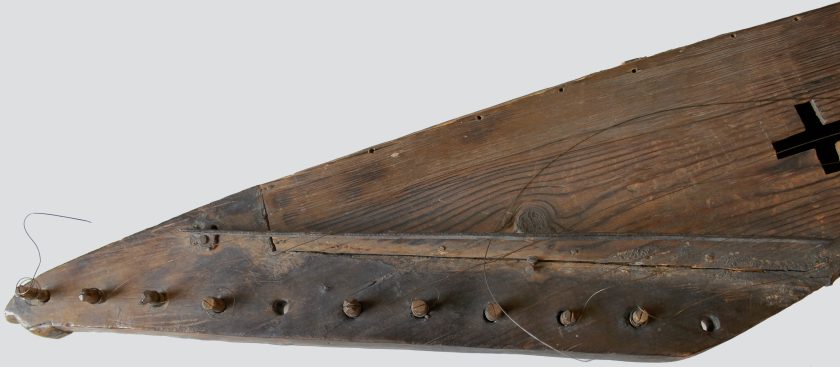
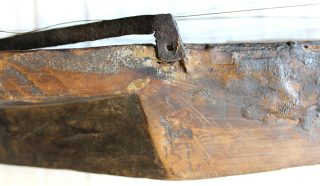 In several places, especially where the kantele is cracked, glue or a glue-like substance has been applied to the surface of the kantele.
In several places, especially where the kantele is cracked, glue or a glue-like substance has been applied to the surface of the kantele.
The crack on the long side has even been patched with stitches. The inside picture shows a chip of wood at the crack. According to the inside picture, there are more stitches than the three shown on the outside. Are the rest under the glue applied on the outside?
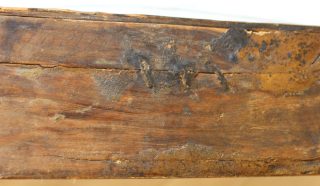
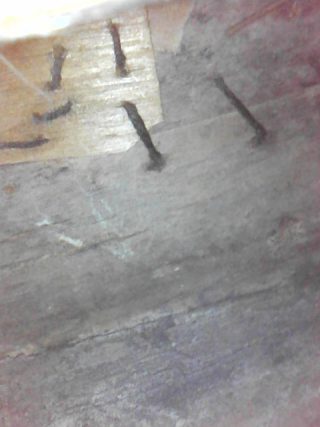 The long side contains text that is difficult to read, interpreted for me by Kari Dahlblom and Olga Harrison. The text is written in old Russian and may contain the name “Krachinko” and “Mapm[T]a[..?..] i.e. March (“Martan”/”Martin”?) and the numbers 74 or 84(?) and “1790 di ” (or 1890? or 1800? – “di” = from the year).
The long side contains text that is difficult to read, interpreted for me by Kari Dahlblom and Olga Harrison. The text is written in old Russian and may contain the name “Krachinko” and “Mapm[T]a[..?..] i.e. March (“Martan”/”Martin”?) and the numbers 74 or 84(?) and “1790 di ” (or 1890? or 1800? – “di” = from the year).
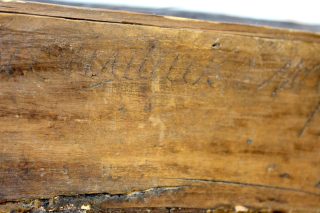
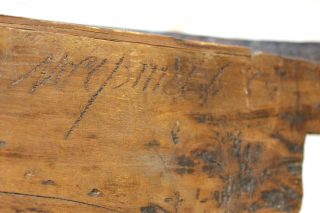
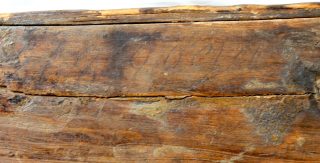
The photos inside show two support bars under the soundboard as a confusing detail. One runs next to the soundhole. It ends at the corner of the short side and the tuning peg side, and its other end is visible on the outside in the middle of the long side. The second bar is close to the ponsi side and rests on the vertical bars placed on the short and long sides.
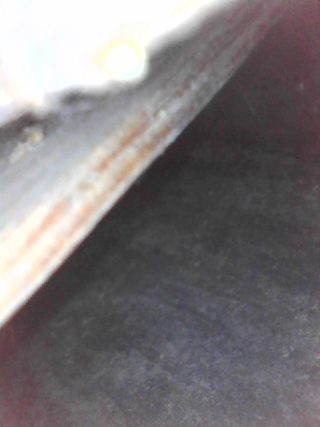
The bar close to the sound hole.
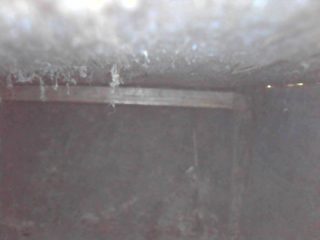
The bar close to the ponsi side.
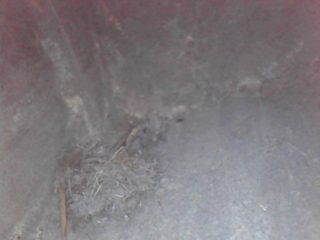
On the ponsi side, dust and debris have accumulated inside.

SM1910. One end of the other bar under the soundboard is visible in the middle of the long side.
The Turku Museum Centre’s kantele TMM8064 has almost similar support bars under the soundboard, but three of them (– the soundboard, which is in poor condition, is in two pieces):

TMM8064. Photo: Arja Kastinen.
The body of the SM1910 kantele is blackened by smoke (– indicating that the instrument has been kept in an old smokehouse). Traces of smoke are particularly visible on the back – the sides of the instrument show signs of polishing.

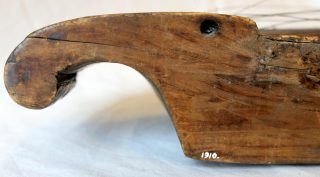
In my opinion, both the many visible damages in the body and their repairs, as well as the dust and debris in the interior, suggest that this is not a copy made by Bergman, but an original hollow kantele (perhaps from somewhere in Russia?).
If this is original, it must have been of great sentimental value to someone who wanted to repair it in many ways rather than build a new one to replace the broken one. 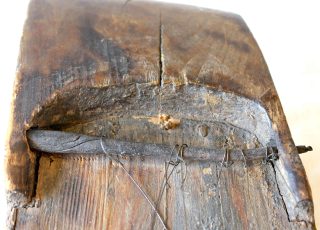 It is also possible that the entire soundboard was replaced at the same time as the soundbox was repaired and the supporting bars were installed. This is suggested by the unevenness of the tips of the sides of the ponsi (“ponnen korvakkeet” in Finnish) – as if they had been cut off? If the soundboard has been replaced, it must have happened a long time ago, as the interior photos show cobwebs and dust hanging from the lid.
It is also possible that the entire soundboard was replaced at the same time as the soundbox was repaired and the supporting bars were installed. This is suggested by the unevenness of the tips of the sides of the ponsi (“ponnen korvakkeet” in Finnish) – as if they had been cut off? If the soundboard has been replaced, it must have happened a long time ago, as the interior photos show cobwebs and dust hanging from the lid.
The tip of the kantele looks like a bird’s head when viewed from the long side. The top of the head is either broken and glued back, or was originally made from a separate piece.
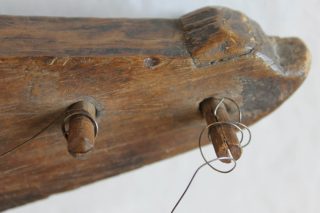
An enigmatic kantele – and there are plenty of them in our museums. 🙂
